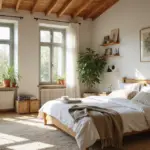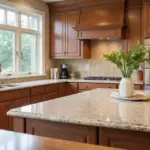Picture this: a frosty Alaskan evening, the Northern Lights dancing outside your window as you gather around a warm, inviting dining table. The walls surrounding you aren’t just a backdrop; they’re an integral part of the experience, setting the tone for countless memories to be made. As someone who’s spent years designing spaces that harmonize with the rugged beauty of the Last Frontier, I can tell you that choosing dining room paint colors is more than just a design decision—it’s about creating an atmosphere that resonates with your soul and the natural world around you.
In this guide, we’ll explore how to select the perfect hues for your dining space, drawing inspiration from the breathtaking landscapes of Alaska and the wisdom of both modern design and traditional knowledge. Whether you’re aiming for the cozy warmth of a log cabin or the sleek sophistication of an urban loft, we’ll help you find colors that not only look great but also feel right for your unique space and lifestyle.
Key Takeaways
Before we dive into the depths of color theory and practical applications, let’s set our bearings with some key points to remember:
- The psychology of color isn’t just theoretical—it’s as real as the changing seasons in Alaska. Blues can bring the serenity of a glacial lake, while yellows might evoke the warmth of the midnight sun.
- For a dining room that exudes elegance, consider deep, rich colors that mirror the intensity of the Aurora Borealis—think navy blues or lush forest greens.
- To create a space as inviting as a cozy igloo, opt for softer, warmer tones that reflect the golden hues of a winter sunset.
- Embrace the simplicity of nature with timeless, minimalistic color schemes inspired by the stark beauty of Arctic landscapes.
- For those who crave energy like the rushing waters of spring breakup, vibrant colors can stimulate conversation and excitement.
- Always test your chosen colors in your space, just as you’d test the thickness of ice before venturing out. The interplay of light and shadow can dramatically affect how a color presents itself.

Psychology of Color
In the vast wilderness of Alaska, color isn’t just visual—it’s visceral. The same holds for your dining room.
Impact on Mood
Colors wield a power as palpable as the Arctic wind. Warm hues like the reds and oranges of a blazing campfire can stoke appetites and conversation. They create an atmosphere charged with energy, perfect for lively dinner parties. On the flip side, cool colors—think of the serene blues of a glacier or the calming greens of a boreal forest—can lower heart rates and foster a sense of tranquility. In a dining room, these colors can transform meals into meditative experiences, allowing diners to truly savor both food and company.
Color Perception
Just as the quality of light changes dramatically with the seasons in Alaska, so too does our perception of color shift with lighting conditions. Natural light, especially the golden hues of the long summer days, can make colors sing with vibrancy. Artificial light, reminiscent of the warm glow of oil lamps in a winter cabin, can cast a different spell entirely. When testing paint colors with lighting, consider how your space will look during different times of day and various seasons. Remember, lighter colors can make a cramped space feel as open as the tundra, while darker shades can create the intimate feel of a snug winter den.

Choosing the Right Shade
Selecting the perfect shade is like planning an expedition—it requires careful consideration and testing. Don’t rely solely on small paint chips; they’re like trying to judge the vastness of Denali from a postcard. Instead, paint large swatches on your walls and observe them over several days. Notice how they interact with your furniture, much like how the landscape interacts with the changing light. Consider the natural light in your space—a north-facing room might benefit from warmer tones to counteract the cool light, much like how a bright fire warms a chilly night.
Elegant and Formal Atmosphere
Creating an elegant dining room doesn’t mean sacrificing the rugged charm of Alaskan style. It’s about finding that perfect balance, like the equilibrium of nature itself.
Elegant Gray Tones
Gray, in all its nuanced shades, is as versatile as the Alaskan landscape. From the soft gray of morning mist over a fjord to the deep charcoal of weather-worn rocks, this color family offers a sophisticated palette for dining rooms. Pair lighter grays with natural wood elements to evoke the feeling of a high-end lodge, or go darker for a more dramatic, formal look reminiscent of upscale Anchorage restaurants. Metallic accents—perhaps inspired by gold rush era decor—can add a touch of luxury that elevates the entire space.

Deep Blue Shades
The deep blues of Alaskan waters—from the midnight depths of the Inside Passage to the intense hue of glacial ice—can bring a profound sense of elegance to your dining area. These colors create an atmosphere of intimacy and sophistication, perfect for formal dinners or special occasions. To prevent the space from feeling too heavy, balance deep blues with lighter elements. Consider white trim to mimic the contrast of snow-capped mountains against a twilight sky, or incorporate pale wood furniture to soften the overall effect.
Black and White Scheme
A black-and-white color scheme in your dining room can be as striking as the contrast between snow and spruce trees in an Alaskan winter. This timeless combination offers endless possibilities for creating a formal, elegant space. Use white as your primary color to reflect light and create a sense of openness, then add black accents for definition and drama. This high-contrast look provides a perfect backdrop for adding textures—perhaps a plush rug reminiscent of bear fur or curtains with a subtle pattern inspired by Native Alaskan art. Remember, in design as in nature, balance is key.
Cozy and Inviting Spaces
In Alaska, creating a warm, inviting space isn’t just about aesthetics—it’s a necessity for surviving long, dark winters. Let’s explore how to bring that essential coziness into your dining room.

Warm Blush Tones
Blush tones, reminiscent of the soft pink hues of an Alaskan sunset reflecting off snow-covered peaks, can infuse your dining room with warmth and comfort. These gentle colors create an inviting atmosphere that encourages lingering conversations over steaming mugs of coffee or hot chocolate. To enhance the cozy factor, consider matching paint to upholstery in complementary warm tones. Pair blush walls with rich, natural textures like wool throws or fur pillows to create a space that feels as welcoming as a well-insulated cabin in the wilderness.
Soft Green Hues
Soft greens, inspired by the first tender shoots of spring breaking through the snow, can bring a sense of renewal and freshness to your dining area. These hues connect your indoor space with the natural world outside, creating a seamless transition that’s especially comforting during the long winter months. Consider a sage green paired with warm wood tones to evoke the feeling of a forest glade. This combination not only looks inviting but can also have a calming effect, making your dining room a perfect retreat for both everyday meals and special gatherings.
Earthy Clay Colors
The rich, earthy tones of clay—from warm terracotta to deep sienna—can ground your dining room in the same way that the land anchors Alaskan communities. These colors, reminiscent of the soil that nourishes wildlife and supports the cycles of nature, create a primal sense of comfort and belonging. An earthy palette works beautifully with natural materials like stone and wood, allowing you to create a dining space that feels rooted and substantial. Consider incorporating elements like a reclaimed wood table or stone accents to enhance the organic, cozy feel of your clay-colored walls.

Timeless and Minimalistic Design
In the vast, often stark beauty of Alaska, there’s a natural affinity for minimalism—a style that celebrates the essence of form and function. Let’s explore how to bring this timeless approach to your dining room.
Almost White Shades
In a land where snow blankets the landscape for much of the year, the power of white is well understood. Almost-white shades in your dining room can create a sense of expansiveness, much like the endless vistas of the Arctic tundra. These light hues maximize the impact of natural light, crucial in a place where winter days are short. Opt for whites with subtle undertones—perhaps a hint of gray like a foggy morning or a touch of cream like sun-bleached driftwood. These nuanced whites provide a clean, bright backdrop that allows other elements in your room to shine, much like how the snowy landscape highlights the beauty of wildlife and the Northern Lights.
Neutral Khaki Options
Khaki, with its earthy warmth, can bring a grounding presence to your dining space. This versatile neutral, reminiscent of the varied tones of Alaskan sand and stone, creates a welcoming atmosphere without overwhelming the senses. Pair khaki walls with natural materials like weathered wood or leather to enhance the organic feel. This combination works particularly well in open-plan spaces, providing a seamless transition between dining areas and living spaces—a layout often favored in modern Alaskan homes designed to maximize light and views.

Simple Monochrome
A monochromatic color scheme, inspired by the subtle gradations of color in an Alaskan glacier or the shifting tones of the tundra, can create a sophisticated, cohesive look in your dining room. Choose a base color—perhaps a steely blue-gray or a soft taupe—and use varying shades and tints of this hue throughout the space. This approach allows for depth and interest without the visual clutter of contrasting colors. Incorporate texture through your choice of materials and finishes to add dimension, much like how the varied textures of ice, snow, and rock create interest in a seemingly monochrome Arctic landscape.
Vibrant and Energetic Dining Rooms
While Alaska is often associated with serene, muted tones, it’s also a land of vibrant contrasts and unexpected bursts of color. Let’s explore how to infuse your dining room with the energy and vitality of the Last Frontier.
Vibrant Teal Choices
Teal, a color that captures the essence of glacial lakes and the flashes of Northern Lights, can bring a dynamic energy to your dining space. This bold hue, balanced between blue and green, evokes the vitality of Alaska’s short but intense summers. Use teal as an accent wall to create a stunning focal point, or go all-in for a room that buzzes with life. To keep the space from feeling overwhelming, balance teal with neutral tones inspired by Alaskan birch bark or river stones. This combination creates a dining room that’s as invigorating as a plunge into a crystal-clear mountain stream.

Bold Accent Walls
In the vast Alaskan wilderness, sometimes a single element—a field of fireweed, a flash of aurora—can transform an entire landscape. Apply this principle to your dining room with a bold accent wall. Choose a color that complements your overall scheme while adding a punch of energy. Perhaps a deep berry red, reminiscent of late-summer blueberries, or a warm gold that echoes the autumn colors of birch leaves. This approach allows you to incorporate vivid color without committing to an entirely bold room. Use your accent wall to highlight architectural features or to define the dining area in an open-plan space.
Playful Color Combinations
Alaska’s landscape is full of unexpected color pairings—think of the contrast between blue glaciers and green forests, or the interplay of pink alpenglow on snow-covered peaks. Bring this sense of playful juxtaposition into your dining room with unexpected color combinations. Consider pairing a warm terracotta with a cool sky blue, or a deep forest green with a bright sunshine yellow. These lively combinations can create a dining space that encourages animated conversation and joyful gatherings. To keep the look cohesive, choose colors with similar intensity levels and use neutrals for balance.
Final Remarks
As we conclude our journey through the world of dining room colors, remember that choosing the right hue is much like planning an Alaskan adventure—it requires thoughtfulness, a willingness to explore, and an appreciation for the beauty that surrounds us. Whether you opt for the serene elegance of deep blues, the cozy warmth of earthy tones, the timeless simplicity of neutrals, or the vibrant energy of bold colors, your dining room should be a reflection of your style and the unique character of your home.

In Alaska, we understand the profound impact that our surroundings can have on our mood and well-being. Your dining room, as a gathering place for family and friends, plays a crucial role in creating those moments of connection that sustain us through long winters and celebrate the abundance of summer. Let your color choices be guided by the landscapes that inspire you, the memories you want to create, and the atmosphere you wish to cultivate.
Now, it’s time to take action. Consider the mood you want to set in your dining space. Is it the calm serenity of a misty fjord, the warm welcome of a cabin hearth, or the vibrant energy of a summer solstice celebration? Select colors that resonate with your vision and start experimenting. Remember, your home should evolve and adapt like the ever-changing Alaskan sky. Don’t be afraid to try new combinations or repaint if a color doesn’t feel right.
As you embark on this color journey, may your dining room become a space that not only pleases the eye but also nourishes the soul—a true reflection of life’s beauty, resilience, and warmth in the Last Frontier. Happy painting, and may your dining room be filled with good food, great company, and the colors of your Alaskan dreams!
Frequently Asked Questions
What are the best paint colors for a dining room in a northern climate?
In northern climates like Alaska, warm neutrals such as soft golds, rich creams, and warm grays can create a cozy atmosphere. These colors mimic the warmth of indoor spaces during long winters while providing a versatile backdrop for decor.
How do colors affect the mood in a dining room, especially during dark winter months?
Colors play a crucial role in mood, particularly during the dark Arctic winters. Warm tones like soft yellows or muted oranges can evoke the feeling of sunlight, while cool blues and greens can create a calming effect reminiscent of glacial landscapes.

What colors make a dining room feel more formal in an Alaskan-inspired design?
Deep, rich colors inspired by the Alaskan wilderness, such as midnight blue, forest green, or even dark charcoal, can add formality and sophistication to a dining space while maintaining a connection to the natural environment.
How can I make my dining room feel cozier with paint in a cold climate?
Opt for warm, earthy tones like rich browns, soft taupes, or muted reds. These colors can create a welcoming ambiance that feels like a warm embrace against the cold outside, encouraging lingering conversations over meals.
Are bold colors suitable for a dining room in a predominantly white landscape?
Absolutely! Bold colors can provide a vibrant contrast to the often white Alaskan landscape. Consider colors inspired by the Northern Lights, such as vivid purples or electric blues, to bring energy and excitement to your dining space.
What is a timeless color palette for a dining room that reflects Alaskan aesthetics?
A palette inspired by the Alaskan landscape—think soft grays, muted blues, and warm whites—offers a timeless and versatile backdrop. This combination reflects the colors of snow, ice, and sky, creating a serene and elegant dining environment.
How do I choose the right color based on my dining room size and the amount of natural light it receives?
In Alaska, where natural light can be scarce, light colors can help brighten small or dark spaces. For larger rooms with ample light, you have more flexibility to use darker or more saturated colors. Always test colors under different lighting conditions, as the long summer days and dark winter nights can dramatically affect how colors appear.






